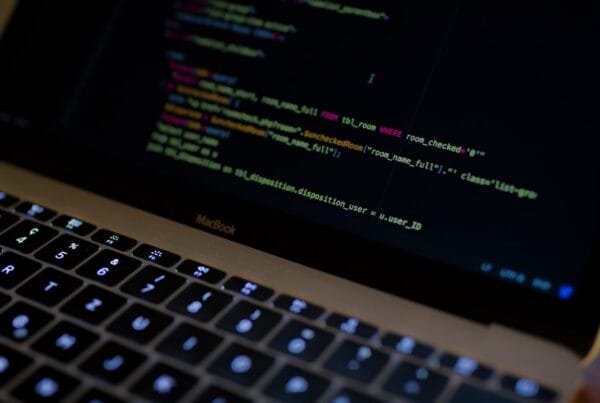Navigating the murky waters of cyber-attacks can be difficult. There are many types of cyber-attacks that can harm devices and steal data. The concern for breeches and attacks is only growing. Compared to 2021, there was a 72% increase of security breaches in 2023.
With around 94% of organizations claiming they have experienced some sort of cyber threat; business owners must stay alert and up to date on the latest security matters to ensure they keep their data safe.
We will discuss four types of cyber-attacks that pose a threat to your business including:
- Phishing
- Ransomware
- Spoofing
- AI powered attacks
PLUS, we include some of our top picks for anti-virus software.
Phishing
One of the most common cyber-attacks is known as phishing. Phishing is normally done through emails and text messages. Those attempting to gain access to information such as passwords will send out links that appear as something they are not. This form of manipulation is known as social engineering. It is meant to trick the user into giving them information just by a click of a button.
There are multiple types of phishing:
- Whaling: Attacks with the goal of stealing money from a company as well as gaining access to their computers
- Vishing: Attacks using fake voices to pose as a trusted source in order to get victims to reveal information. Typically, they are carried out by calls and voicemails.
- Smishing: Text messages in which phishers pretend to be a trusted source such as a delivery service or bank. The messages will say things like, “Your UPS package was not delivered” Then, they ask you to click on a link that allows them to gain access to your information.
Ransomware
Ransomware is the act of installing malware onto someone’s computer in which their data is taken from them. In these instances, hackers use malware to demand ransom. Victims are typically large sector organizations such as financial institutions, schools, government entities, etc. It allows hackers to demand large amounts of money.
Ransomware is carried out through several different methods including:
- Screen lockers: This method completely locks victims out of their device. They are unable to get past the lock screen. Often, the hackers scare them with a sense of urgency to get victims to pay quicker.
- Encrypting ransomware: This occurs when files are encrypted by the hackers, and victims have to pay in order for the data do be decrypted.
- Scareware: Usually in the form of pop ups, scareware gets victims to install viruses on to their devices after telling them their computer has a bug and if they download the software, it will be fixed. Meanwhile, the software is dangerous and actually is a virus.
Spoofing
Spoofing is done by a hacker who poses to be a trusted source to engage with the victim. This can take place in multiple forms including over the phone, text message, emails, etc. They may also create an access point in the victim’s Wi-Fi in order to gain access to more information.
Some examples of spoofing include:
- Caller ID spoofing: A disguise over the phone such as a customer service representative that converses with the victim. The spoofer is able to ask the victims personal questions such as bank account information because they are pretending to be a trusted source.
- IP spoofing: Attackers are able to disguise their IP address in order to appear as if they are someone else. IP spoofing can be carried out through several different attacks such as a DoS attack.
- GPS spoofing: Attackers are able to hack into GPS systems and reroute navigation. They are also able to intercept the GPS and place its location wherever they want. This can happen to any vehicle including public transportation.
AI Powered Attacks
In the age of artificial intelligence, cyber-attacks are becoming more frequent and easier to carry out. AI allows hackers to automate their processes. It is able to pick up on patterns and understand data quicker.
Due to the young age of AI, cyber security analysts have had to grow more innovative in developing ways to protect and counteract AI driven cyber-attacks.
Here are some common AI driven cyber-attacks:
- Deepfakes: AI that is able to replicate a person’s looks, mannerisms, etc. This is used by hackers in order to impersonate a trusted source. Deepfakes can result in extortion and other similar crimes.
- Model theft: Hackers are able to use AI in order to detect large amounts of data that would otherwise take longer. The information they collect is usually sensitive information. They use this method to their advantage when committing cyber-attacks.
- Data poisoning: Hackers are able to train their AI tools to “poison data” to change or manipulate information.
Recommended Antivirus Software
One of the most important things to have on your devices is an anti-virus software. There are plenty options on the market that allow customers to protect their data and computer health. Anti-virus software can detect and delete any threats posed against your computer.
Below, we will provide you with two anti-virus software applications that we recommend. These are hand selected for their reliability and easy implementation:
Bitdefender has been continuously ranked in the top anti-virus software applications for several years. They provide protection for home computers, businesses and business partnerships. Their services are available for MacOS, Windows, Android and Linux.

Bitdefender offers several different priced packages to fit your needs. Their lowest package comes in at around $29.99.
Malware is a highly trusted antivirus software that has continuously provided 100% accurate results with no errors. Their services are compatible with Windows, MacOS and android. They also provide their customers with support in helping set up their devices and assisting customers with any questions they may have.

Malwarebytes provides services to businesses and for personal use. Pricing depends on the customer’s needs.
Conclusion
Cyber-attacks pose a threat to all users including small businesses. Bitdefender and Malwarebytes are two of our favorite anti-virus tools with easy-to-use features.
Although ALL businesses should have some sort of anti-virus software, there is no application that completely blocks cyber-attacks. Leave it to the professionals to ensure your devices are kept safe.
Contact us today for cyber security and IT services.






